Care & Repairs
Hardwood Furniture Care
Mature hardwoods supply the nation, and much of the world, with timber used for everything from railroad ties to quality furnishings. U.S. hardwoods are coveted the world over for their warmth and lasting beauty in furniture, cabinetry, millwork and flooring. In finished products, hardwoods are the purest expression of nature. They are not synthetic nor are they engineered. Their beauty is not skin deep, And, thanks to responsible stewardship of America's hardwood forestlands, their supply is abundant and perpetually renewing.
Hardwoods are such broad-leafed trees as oak and walnut, cherry and maple, hickory and poplar, and dozens of other species. Each autumn their green leaves burst into brilliant symphonies of amber, orange, magenta, and thousands of hues in between
Hardwoods grow prolifically, reaching maturity at about 80 years. When harvested, they often begin a second life as home furnishings that we can cherish for generations
Just as each tree is different from the next, so, too are hardwood products individually unique. Hardwoods are characterized by an infinite variety of grains and distinctive textures. Trees grow limbs that fall off as the tree matures. What remains is a knot on the hardwood surface. These natural markings add character to the woods appearance and have absolutely no effect on the wood's durability and stability.
Care of Solid Hardwood Furniture
With proper care your solid hardwood furniture can provide years of pleasure for your family. Here are some tips to be sure you get the most from your table
- Maintain a humidity-controlled environment. Your home should be kept in the 35-45% humidity range to prevent warping and cracking.
- Keep table out of reach of direct continued sunlight and away from heat sources such as furnace ducts, radiators and fireplaces.
- Use coasters and trivets with non-scratching bottoms underneath glasses and serving dishes placed on the table.
- Store table leaves in or close to the table to maintain consistent environmental conditions.
- Avoid placing sharp objects that could scratch the surface directly on the table.
- Avoid the use of nail polish remover, alcohol or other solvents near table.
- Dust table often and carefully with a soft cloth following the grain pattern or remove abrasive dust particles.
- Periodically clean table with a mild, non-alkaline soap and water using a soft sponge or cloth. Dry immediately with soft cloth and buff lightly following wood grains.
- Avoid polish that contains and silicones. Ask your retailer to recommend a polish or wax.
Furniture Repair
The following is a list of common problems and solutions to help maintain your table's appearance. Always test these solutions in small, out of sight sections to be sure the finish will not be harmed
- Cigarette Burns: Minor burns can be fixed by rubbing with a paste of linseed oil and rottenstone, working with the grain until the burn disappears.
- Heat Marks: Rub along the grain with a dry steel wool soap pad, extra fine (0000) steel wool or cloth dampened with camphorated oil or mineral spirits.
- Milk or Alcohol: Rub in a paste of boiled linseed oil and rottenstone with the grain, substituting pumice for dull finishes.
- Nail Polish: Blot out the spill immediately. Then rub with fine steel wood (0) dipped in Guardsman Furniture Polish. Wipe dry.
- Paint: If fresh, remove latex pain with water and oil based mineral spirits. If dry, soak spot in boiled linseed oil, wait until soft and carefully remove with putty knife or cloth dampened with boiled linseed oil. Remove residue by rubbing along the grain with a paste of linseed oil and rottenstone. Wipe dry.
- Sticking Paper: Dampen the paper with salad oil, wait five minutes and rub along the grain with extra fine (0000) steel wool dipped in mineral spirits.
- Water Marks: Rings are often in the wax, not in the finish. Cover the ring with a clean thick blotter and press down with a warm iron. Repeat as needed. Or rub with salad oil, mayonnaise or white toothpaste, wipe dry.
- White Marks: Rub with cloth dipped in a mixture of cigarette ashes and lemon juice or salad oil. Or rub with a cloth dipped in lighter fluid, followed by a mixture of rottenstone and salad oil. Wipe dry.
- Wax or Gum: Harden the substance by holding an ice cube wrapped in a cloth against it. Pry off with fingernail. Rub the area with extra fine (0000) steel wool dipped in mineral spirits. Wipe dry.
Hardwood Information
Wood Species
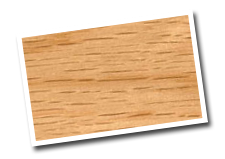
Red Oak
Red Oak is an extremely strong, tough wood that has a pronounced open grain. Red Oak has a slight orange or reddish hue. This is the wood you want if you love a warm look.

Quarter Sawn White Oak
Quarter-sawn means cutting into the log at a 90-degree angle to the growth rings which gives it a special grain pattern. If you love a lot of grain in your table quarter sawn is for you. The White Oak has a cooler white to sage undertone.

Cherry
Cherry is a hard durable wood that has a reddish-brown tone with a tight, straight grain that becomes darker and richer as it ages. This is preferred by folks that want a slight but elegant grain.
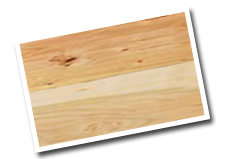
Rustic Cherry
Rustic cherry is merely a more unrefined wood then the traditional cherry wood. Most builders will cut the wood in such a way that the amount of pits, sap wood, and knots are minimized. In Rustic Cherry those natural characteristics of Cherry are accentuated. Color ranges from white, brown to deep red with brown flecks.
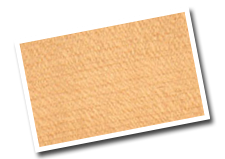
Maple
Maple is the hardest domestic wood that we have here in the US. It is used extensively in furniture making because of its fine texture and durability. Maple is basically cream or ivory in color with minimal grain. This wood captures light and brightens space.
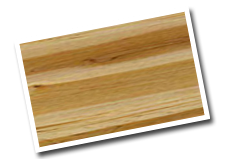
Brown Maple
Brown Maple combines the browns, tans, whites and creams to give a rustic feel. Because it is a softer hardwood staining it a light color, makes the stain appear blotchy. This wood is great for staining medium to dark colors or painting.
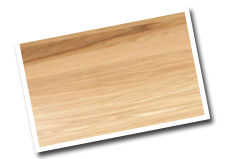
Hickory
The contrasting reddish and cream colors make Hickory a beautiful wood for furniture. It has a medium grain that gives the feel earthy but with a smooth look.
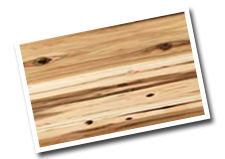
Rustic Hickory
Rustic Hickory, much like Rustic Cherry, is a more unrefined wood than Hickory. You can really see a stark contrast between the sap wood and center wood.

Walnut
Walnut is a rich chocolate or purplish brown in color with hints of grey, black and even dark blue. It has a beautiful grain pattern and is the only dark brown domestic hardwood. Over time is will take on a bit of a golden brown color, but it is very slight and mostly unnoticeable. Walnut isn’t as hard red oak or maple but it is harder than cherry.
Wood Stains
Go to this link to see Stain Color Samples. Please Click on the names of the Stains to see the Color.
